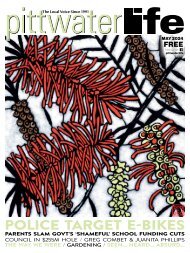Pittwater Life July 2024 Issue
GOVT’S BUDGET SNUB CONCERN NARRABEEN LAND IS ‘FALLING INTO LAGOON’ AVALON’S RUSKIN ‘ROW’ OVER TREES / PUBLIC ALCOHOL BAN THE WAY WE WERE / ARTISTS TRAIL / SEEN... HEARD... ABSURD...
GOVT’S BUDGET SNUB
CONCERN NARRABEEN LAND IS ‘FALLING INTO LAGOON’
AVALON’S RUSKIN ‘ROW’ OVER TREES / PUBLIC ALCOHOL BAN
THE WAY WE WERE / ARTISTS TRAIL / SEEN... HEARD... ABSURD...
Create successful ePaper yourself
Turn your PDF publications into a flip-book with our unique Google optimized e-Paper software.
Garden <strong>Life</strong><br />
Garden <strong>Life</strong><br />
Your <strong>July</strong> to-do list...<br />
Potted plants<br />
If you are out of space in the<br />
garden, potted plants are<br />
a great idea – and Winter<br />
is a great time to get them<br />
established. Most plants will<br />
thrive in pots for an extended<br />
period; for most plants it is<br />
not a forever home but for<br />
some, if treated well, can last<br />
years in the same pot. Also,<br />
potted plants are a great<br />
option for the smaller gardens,<br />
townhouses and apartments.<br />
You can reposition the pots<br />
as the seasons change. If the<br />
plant outgrows the pot and<br />
don’t want to discard it, you<br />
can pot-up the plant into a<br />
larger size, root prune the<br />
plant and place into the same<br />
pot with fresh soil, or plant it<br />
into your garden.<br />
Potted plants will require a<br />
bit more love than plants in<br />
the ground – plants will need<br />
regular watering as the pots<br />
will dry out quicker.<br />
And keep the fertiliser<br />
up to keep them looking<br />
healthy. Our favourite native<br />
plants for pots are Banksias,<br />
Anigozanthos (Kangaroo Paw),<br />
Xerochrysum (Paper Daises),<br />
Dendrobium orchids, Ferns<br />
and Xanthorrhoea (Grass<br />
Trees). Favourite exotics for<br />
pots include Olives, Citrus,<br />
Rhapis Palms, Bromeliads,<br />
Philodendron and Maple Trees.<br />
Weeds of the month<br />
At times it can be a real pain<br />
trying to get on top of weeds,<br />
even just in our own backyard.<br />
Don’t let them get the better<br />
of you! The cooler months<br />
are a great time to do some<br />
weeding.<br />
As well as the aesthetic<br />
impact, they can also harbour<br />
pests, have a negative impact<br />
on the local ecosystems and<br />
compete for resources and<br />
nutrients with our desired<br />
plants. Weeds can also spread<br />
rapidly and can take over<br />
the garden if not controlled,<br />
making the maintenance more<br />
challenging. Highlighting two<br />
common weeds in our area<br />
that can be a real nuisance to<br />
remove are Onion Weed and<br />
Ground Asparagus.<br />
Onion Weed (pictured<br />
above) can be a real challenge<br />
due to its ability to re grow<br />
from bulbs and seeds. Manual<br />
removal is the most common<br />
method – with gloves on dig<br />
down around the base of<br />
the plant and try to remove<br />
the entire bulb and as much<br />
roots as possible; remove<br />
the bulb gently as fragments<br />
can drop off and re-grow. As<br />
a last resort you can use a<br />
selective herbicide designed<br />
to target Onion Weed and<br />
follow instructions. Always<br />
try to remove flowers if ever<br />
you see them as that stops<br />
the plant from going to seed<br />
and carefully dispose of any<br />
bulbs.<br />
Asparagus aethiopicus or<br />
Ground Asparagus grows very<br />
densely above the ground<br />
and forms thick mats of<br />
tubers and roots underground<br />
making larger plants very<br />
difficult to remove. Smaller<br />
plants and seedlings can<br />
be easily removed by hand;<br />
ensure the crown is removed<br />
and disposed. Another<br />
technique commonly used<br />
in bush regeneration is<br />
‘crowning’; it involves digging<br />
out the entire crown that<br />
sits just below the surface<br />
of the soil. Roots and tubers<br />
can be left in the soil. This<br />
helps prevent excessive soil<br />
disturbance in sensitive areas,<br />
particularly coastal dune<br />
environments.<br />
Remove stems and foliage<br />
to get access to the crown.<br />
Use a sharp knife or trowel<br />
to cut all of the roots around<br />
the crown just below the<br />
surface. Lever the crown out<br />
of the ground and dispose of<br />
it. Any small segment of the<br />
crown that is left behind can<br />
regrow.<br />
If all else fails, chemical<br />
controls can be effective.<br />
Cut the stems then gouge<br />
out a section of the crown<br />
with a knife. Apply the<br />
herbicide to the gouged crown<br />
immediately.<br />
Crossword solution from page 63<br />
Mystery location: NEWPORT BEACH<br />
66 JUNE <strong>2024</strong><br />
The Local Voice Since 1991
















